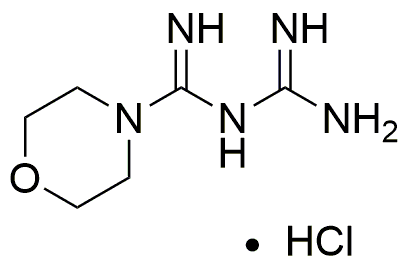Moroxydine hydrochloride is widely utilized in research focused on:
- Antiviral Applications: Primarily used in the development of antiviral medications, it has shown effectiveness against various viral infections, making it valuable in pharmaceutical research.
- Pharmaceutical Formulations: Commonly incorporated into formulations for treating respiratory infections, providing a targeted approach to managing viral pathogens.
- Laboratory Research: Employed in laboratory settings to study viral replication mechanisms, aiding researchers in understanding viral behaviors and developing new treatments.
- Clinical Trials: Frequently a subject in clinical trials aimed at evaluating its efficacy and safety, contributing to the advancement of antiviral therapies.
- Comparative Studies: Used in comparative studies with other antiviral agents, allowing researchers to assess its performance and potential advantages in treating specific infections.
General Information
Properties
Safety and Regulations
Applications
Moroxydine hydrochloride is widely utilized in research focused on:
- Antiviral Applications: Primarily used in the development of antiviral medications, it has shown effectiveness against various viral infections, making it valuable in pharmaceutical research.
- Pharmaceutical Formulations: Commonly incorporated into formulations for treating respiratory infections, providing a targeted approach to managing viral pathogens.
- Laboratory Research: Employed in laboratory settings to study viral replication mechanisms, aiding researchers in understanding viral behaviors and developing new treatments.
- Clinical Trials: Frequently a subject in clinical trials aimed at evaluating its efficacy and safety, contributing to the advancement of antiviral therapies.
- Comparative Studies: Used in comparative studies with other antiviral agents, allowing researchers to assess its performance and potential advantages in treating specific infections.
Documents
Safety Data Sheets (SDS)
The SDS provides comprehensive safety information on handling, storage, and disposal of the product.
Product Specification (PS)
The PS provides a comprehensive breakdown of the product’s properties, including chemical composition, physical state, purity, and storage requirements. It also details acceptable quality ranges and the product's intended applications.
Certificates of Analysis (COA)
Search for Certificates of Analysis (COA) by entering the products Lot Number. Lot and Batch Numbers can be found on a product’s label following the words ‘Lot’ or ‘Batch’.
*Catalog Number
*Lot Number
Certificates Of Origin (COO)
This COO confirms the country where the product was manufactured, and also details the materials and components used in it and whether it is derived from natural, synthetic, or other specific sources. This certificate may be required for customs, trade, and regulatory compliance.
*Catalog Number
*Lot Number
Safety Data Sheets (SDS)
The SDS provides comprehensive safety information on handling, storage, and disposal of the product.
DownloadProduct Specification (PS)
The PS provides a comprehensive breakdown of the product’s properties, including chemical composition, physical state, purity, and storage requirements. It also details acceptable quality ranges and the product's intended applications.
DownloadCertificates of Analysis (COA)
Search for Certificates of Analysis (COA) by entering the products Lot Number. Lot and Batch Numbers can be found on a product’s label following the words ‘Lot’ or ‘Batch’.
*Catalog Number
*Lot Number
Certificates Of Origin (COO)
This COO confirms the country where the product was manufactured, and also details the materials and components used in it and whether it is derived from natural, synthetic, or other specific sources. This certificate may be required for customs, trade, and regulatory compliance.


